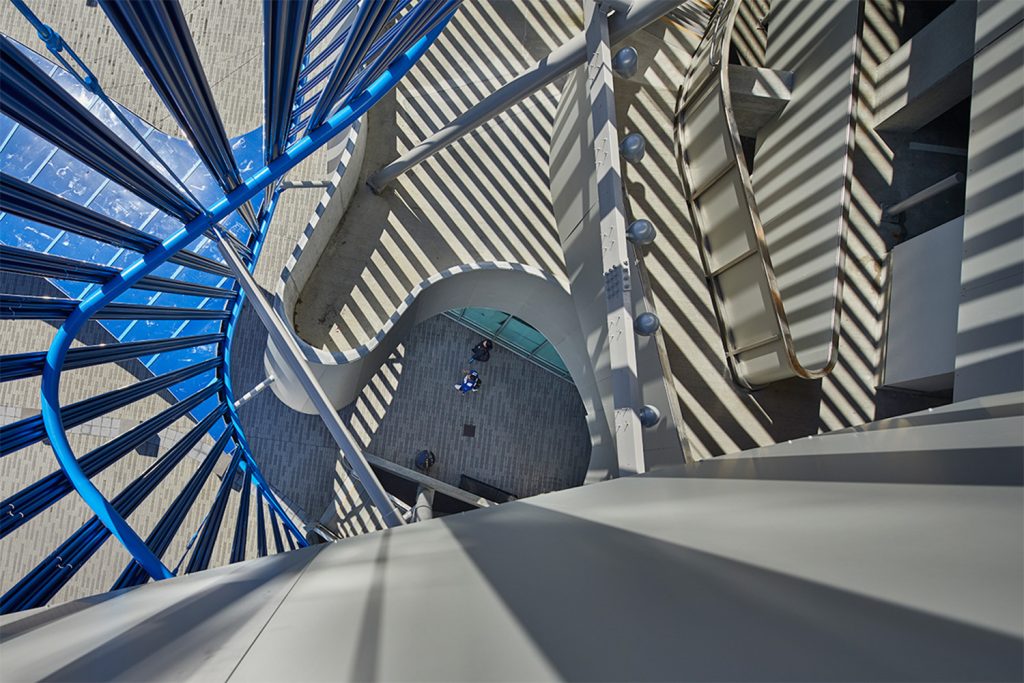Angle Lake Station, designed by BROOKS + SCARPA, is a seven-acre, 400,000-square-foot mixed-use complex that gives essential interconnected public transportation as well as important public spaces, bridging gaps among diverse socioeconomic groups, crossing chasms of race and economic class and forming new social boundaries that foster a stronger sense of community to create a modern-day civic space.
Inspired by William Forsythe’s improvisational piece ‘Dance Geometry,’ in which dancers connect their bodies by matching lines in space that could be bent, tossed, or otherwise distorted, the façade design investigates the possibilities where simple straight lines can be combined to produce an infinite number of movements and positions with very little need for change. This concept reduces the need to consider the end result and instead focuses on exploring new methods of movement and transformations.
The undulating façade is created by connecting two curves with a succession of straight lines using a mathematical method of governed surface geometry. Each custom aluminum façade element was designed and divided into standardized sizes to achieve the most effective structural shape and material form while minimizing production, fabrication, and installation costs.
A comprehensive approach to transit was the ultimate goal, from planning to detailing, by offering users an excellent quality station that is unique, accessible, safe, and comfortable. The project’s performance is more than 35% more efficient than standard energy usage due to passive sustainable measures like cross ventilation, deep overhangs for shading, eco-friendly materials, and a naturally ventilated garage in addition to high-efficiency LED smart lighting and a 40kw photovoltaic solar system. The structure not only promotes sustainable transportation methods but also promotes energy conservation inside its own footprint.
The design and development process resulted from careful consideration and the application of passive design methods. These tactics include positioning and orienting the building to regulate solar cooling loads, shaping the building to be exposed to prevailing winds, and aligning the building to induce buoyancy for natural ventilation, which saves energy because mechanical ventilation is not required. It employs super-efficient LED lighting while maximizing natural daylighting and minimizing the need for artificial illumination. The front of the building was planned as a set of uniform components to eliminate waste and simplify installation.


Concrete with a minimum of 25% fly ash content, building insulation with a minimum of 20% recycled glass cullet, and formaldehyde-free were the primary materials chosen. Recycled and post-consumer gypsum boards containing 31% recycled content and 26% post-consumer waste were also included. All of the paints chosen had no VOCs. The floor is finished with an exposed concrete slab. A high-quality primer and paint solution were chosen when painting was required. Approximately 80% of construction waste was either recycled or reused.
Because the building is a public facility and is subjected to heavy usage, the main material is cast-in-place concrete, and finishes were kept to a minimum throughout. Wherever feasible, concrete slabs were left exposed. For the top deck, fly ash and silica fume were combined with Portland cement that complied with ASTM C150 and had a water-cement ratio of less than 0.40 to form an additional waterproof concrete barrier there. Durability surpasses ACI 362.1R and is expected to survive for more than 55 years. The external metal screens are made of aluminum with an anodized finish that will never need any painting or refinishing. They are lightweight, and the modular design allows for the quick removal of pieces that can be repaired or updated without the use of special equipment.
The Angle Lake Station is the outcome of over a decade of public efforts, community discussions, countless community workshops, and transit expert sessions as part of a public process that resulted in a 1996 voter approval for the $383 million 1.6-mile light rail extension and Angle Lake Station. The completed project has significantly influenced the present neighborhood and is an asset to the city.
Project Info
Architects: Brooks + Scarpa
Area: 402500 ft²
Year: 2017
Manufacturers: Lacker, Portland, Selux, Stepstone
Local Engineers/Architects: BergerABAM
Engineering: BergerABAM, Stantec, Sazan Group, Luminescence, Shannon & Wilson
Landscape: Brooks + Scarpa, David Sacamano-BergerABAM
Contractor: Harbor Pacific/Graham
Project Team – Brooks + Scarpa: Lawrence Scarpa, Angela Brooks, Mario Cipresso, Emily Hodgdon, Mark Buckland, Eleftheria Stavridi, Jeff Huber, Chinh Nguyen, Diane Thepkhounphithack, Cesar Delgado, Fui Srivikorn, Christina Wilkinson, Royce Scortino, Sheisa Roghini, Soha Momeni, Ryan Bostic
Project Team – Berger Abam: Bob Griebenow, Lars Holte
Wayfinding: Brooks + Scarpa
Specifications: BergerABAM, Brooks + Scarpa
Facade Engineering: P.E., Brooks + Scarpa, Lars Holte, Walter P. Moore & Associates
Facade Fabrication: APEL Extrusions and Intermountain Industrial Fab
Client/Owner: Sound Transit
Photographs: Ben Benschneider























Leave a comment